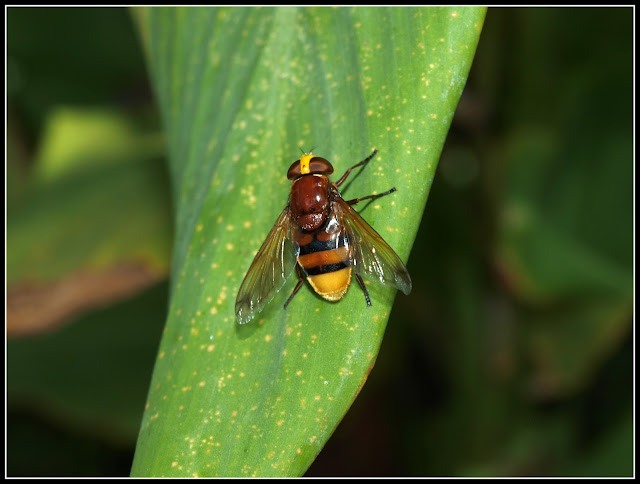I tried very hard to get some good photos of those turtles (and their colleagues), but without a very long lens (which I haven't got), this is the best I could do:
Most of the time this is the sort of view that greeted me - turtles all round the pond scuttling for cover as soon as they saw / heard me.
The pond was also full of frogs, which were a little less shy. I don't know what type of frogs they are, but they are evidently masters of the art of camouflage. Look how well they blend in with the brown patches on the dying lily-pads:
This one was obviously a born poser:
Now moving away from the lily-pond, here are some very different creatures. The hotel has a flock of about 15 ducks of various sorts. Last year we saw a white one with a very distinctive crest. Because of this he was nicknamed "Elvis". This year we learnt that "Elvis" was actually "Elvira" and had unexpectedly produced a brood of ducklings! Unfortunately the attrition rate amongst the ducklings is very high (foxes are the presumed culprits) and only two of Elvira's brood remain, but aren't they cute?
This probably doesn't count as wildlife, since it's domesticated, but I think it fits the general theme of my post...
 |
| Pet rabbit |
Here are some wasps building a nest in a Pomegranate tree. They have some way to go yet, I think...
Can anyone identify what type of wasp these are?
The production of honey is a major industry in this region of Turkey, and everywhere you look there are rows and rows of the distinctively blue-painted bee-hives. I asked our tour guide why all the hives are painted blue. I thought that maybe blue attracts bees better than other colours, but apparently not. It's just that hives are traditionally painted blue and no-one seems to remember why!
 |
| Bees on Lantana flower |
 |
| Bee disappearing into a flower of a Prickly Pear cactus |
 |
| Bee on a Zinnia flower |
 |
| Bee doing acrobatics on a chilli stalk |
In terms of the wildlife, this next photo is my most treasured one. Kingfishers. Not just one, but two together! We saw these birds often, usually in the early morning and the evening, flying up and down the line of the river. Wow, they fly fast. A photo of a kingfisher in flight must be very rare indeed. Luckily, this pair stopped for a while just below our balcony, perching on the river-bank waiting for some poor unsuspecting fish to swim by. Again, my standard camera lens doesn't really do the subject justice, but at least it allows me to provide evidence of the sighting.















Oh Mark, kingfishers how wonderful. I think I may have to invest in a proper camera.
ReplyDeleteLovely, just lovely. I have some ducks just like that. You can tell the males because one feather on the tail will curl up.
ReplyDeleteHi Mark,
ReplyDeleteRegarding the colour blue, I was talking to a bee keeper the other week and he did say that bees are attracted to the colour blue and will therefore visit blue flowers first so perhaps there is a good reason for the hives to be blue in colour after all...
What an amazing place for wildlife - you're becoming the David Attenborough of the blogging world at this rate. Fantastic kingfisher shots - lucky you to be able to get a photo
ReplyDeleteWhat great photos! I think your paper nest wasps are bald faced hornets/wasps and, if so frankly I'm amazed they let you get that close. The fly thing with the big eyes might be a Syrphid fly. And I just loved the pics of the Kingfishers, I haven't seen them in 22 years - thanks for the treat.
ReplyDeleteAll your photos are simply beautiful. I especially love the Kingfishers, as I have never seen them before. Really quite stunning!
ReplyDeleteLooks like a wonderful spot, and so much going on!
ReplyDeleteFantastic photo's. Can't believe those turtles can make it up that incline. Love the kingfishers too.
ReplyDeletenice photos, Mark. Love the Kingfishers!
ReplyDelete